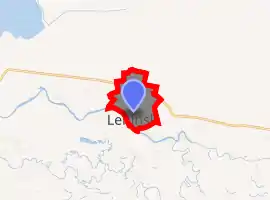Leninsk, Volgograd Oblast
Leninsk (Russian: Ле́нинск) is a town and the administrative center of Leninsky District in Volgograd Oblast, Russia, located on the left bank of the Akhtuba River, 78 kilometers (48 mi) east of Volgograd, the administrative center of the oblast. Population: 15,504 (2010 Census);[3] 14,866 (2002 Census);[8] 13,110 (1989 Census).[9] The town was named after Vladimir Lenin.
Leninsk
Ленинск | |
|---|---|
Town[1] | |
 Flag  Coat of arms | |
Location of Leninsk 
| |
 Leninsk Location of Leninsk  Leninsk Leninsk (Volgograd Oblast) | |
| Coordinates: 48°42′N 45°13′E | |
| Country | Russia |
| Federal subject | Volgograd Oblast[1] |
| Administrative district | Leninsky District[1] |
| Town of district significance | Leninsk[2] |
| Founded | 1802 |
| Town status since | 1963 |
| Elevation | 0 m (0 ft) |
| Population | |
| • Total | 15,504 |
| • Estimate (2018)[4] | 15,064 (−2.8%) |
| • Capital of | Leninsky District[1], town of district significance of Leninsk[2] |
| • Municipal district | Leninsky Municipal District[5] |
| • Urban settlement | Leninsk Urban Settlement[5] |
| • Capital of | Leninsky Municipal District[5], Leninsk Urban Settlement[5] |
| Time zone | UTC+4 (MSK+1 |
| Postal code(s)[7] | 404620 |
| OKTMO ID | 18630101001 |
| Website | www |
History
It was founded in 1802 as the village of Prishibinskoye (Пришибинское) and was later renamed Prishib (Пришиб). It was renamed Leninsk in 1919 and granted town status in 1963.
Administrative and municipal status
Within the framework of administrative divisions, Leninsk serves as the administrative center of Leninsky District.[1] As an administrative division, it is incorporated within Leninsky District as the town of district significance of Leninsk.[2] As a municipal division, the town of district significance of Leninsk is incorporated within Leninsky Municipal District as Leninsk Urban Settlement.[5]
References
Notes
- Государственный комитет Российской Федерации по статистике. Комитет Российской Федерации по стандартизации, метрологии и сертификации. №ОК 019-95 1 января 1997 г. «Общероссийский классификатор объектов административно-территориального деления. Код 18 230», в ред. изменения №278/2015 от 1 января 2016 г.. (State Statistics Committee of the Russian Federation. Committee of the Russian Federation on Standardization, Metrology, and Certification. #OK 019-95 January 1, 1997 Russian Classification of Objects of Administrative Division (OKATO). Code 18 230, as amended by the Amendment #278/2015 of January 1, 2016. ).
- Государственный комитет Российской Федерации по статистике. Комитет Российской Федерации по стандартизации, метрологии и сертификации. №ОК 019-95 1 января 1997 г. «Общероссийский классификатор объектов административно-территориального деления. Код 18 230 501», в ред. изменения №278/2015 от 1 января 2016 г.. (State Statistics Committee of the Russian Federation. Committee of the Russian Federation on Standardization, Metrology, and Certification. #OK 019-95 January 1, 1997 Russian Classification of Objects of Administrative Division (OKATO). Code 18 230 501, as amended by the Amendment #278/2015 of January 1, 2016. ).
- Russian Federal State Statistics Service (2011). "Всероссийская перепись населения 2010 года. Том 1" [2010 All-Russian Population Census, vol. 1]. Всероссийская перепись населения 2010 года [2010 All-Russia Population Census] (in Russian). Federal State Statistics Service.
- "26. Численность постоянного населения Российской Федерации по муниципальным образованиям на 1 января 2018 года". Federal State Statistics Service. Retrieved January 23, 2019.
- Law #1004-OD
- "Об исчислении времени". Официальный интернет-портал правовой информации (in Russian). June 3, 2011. Retrieved January 19, 2019.
- Почта России. Информационно-вычислительный центр ОАСУ РПО. (Russian Post). Поиск объектов почтовой связи (Postal Objects Search) (in Russian)
- Russian Federal State Statistics Service (May 21, 2004). "Численность населения России, субъектов Российской Федерации в составе федеральных округов, районов, городских поселений, сельских населённых пунктов – районных центров и сельских населённых пунктов с населением 3 тысячи и более человек" [Population of Russia, Its Federal Districts, Federal Subjects, Districts, Urban Localities, Rural Localities—Administrative Centers, and Rural Localities with Population of Over 3,000] (XLS). Всероссийская перепись населения 2002 года [All-Russia Population Census of 2002] (in Russian).
- "Всесоюзная перепись населения 1989 г. Численность наличного населения союзных и автономных республик, автономных областей и округов, краёв, областей, районов, городских поселений и сёл-райцентров" [All Union Population Census of 1989: Present Population of Union and Autonomous Republics, Autonomous Oblasts and Okrugs, Krais, Oblasts, Districts, Urban Settlements, and Villages Serving as District Administrative Centers]. Всесоюзная перепись населения 1989 года [All-Union Population Census of 1989] (in Russian). Институт демографии Национального исследовательского университета: Высшая школа экономики [Institute of Demography at the National Research University: Higher School of Economics]. 1989 – via Demoscope Weekly.
Sources
- Волгоградская областная Дума. Закон №1004-ОД от 14 февраля 2005 г. «Об установлении границ и наделении статусом Ленинского района и муниципальных образований в его составе». Вступил в силу со дня официального опубликования. Опубликован: "Волгоградская правда", №35, 1 марта 2005 г. (Volgograd Oblast Duma. Law #1004-OD of February 14, 2005 On Establishing the Borders and Granting the Status to Leninsky District and the Municipal Formations Comprising It. Effective as of the day of the official publication.).